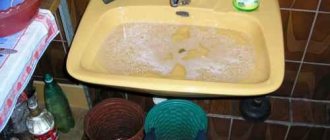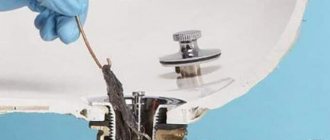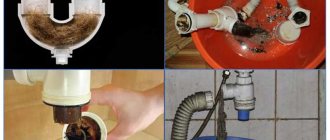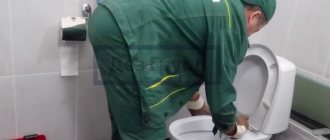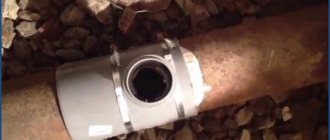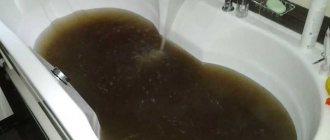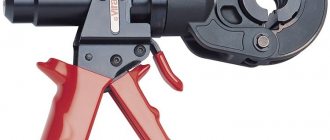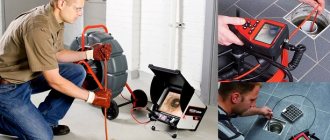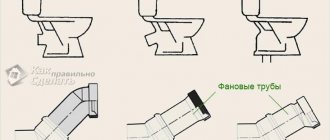Use of chemicals
In addition to self-made mixtures, other methods of cleaning sewer pipes are used. Now any store can boast a huge selection of various chemical products specially created to remove blockages in the sewer. There are not only domestic products, but also foreign ones. There should be no doubt when choosing one or another product, since they all do their job perfectly.
The only caveat is that you just need to read the instructions before use, although usually all you need to do is just pour the solution into the pipe and wait a while.
Removing blockages mechanically
You can also break through a blockage in a pipe at home mechanically, using a brush, plunger, cable or metal wire with a brush at the end. The degree of sewer blockage will influence the choice of tool for the job. For example, a shallow blockage can be broken through using a brush - making sharp movements.
To clean pipes with a plunger, you need to perform the following steps:
- Place the tool over the drain channel.
- Open the water and fill the sink with enough water to cover the bowl of the plunger.
- Make sure there is no water under the plunger.
- Perform 15-20 vertical swinging movements without lifting the tool from the surface.
If all other methods of mechanical cleaning have failed, you will have to use a cable. However, this procedure is the most difficult. The cable is very rigid because it is made of twisted wire rolled into a rod with a cross-section of 3-5 mm.
The procedure for using the cable is as follows:
- first dismantle the siphon;
- the end of the cable with the handle is inserted into the sewer pipe and, turning it counterclockwise, is gradually immersed;
- during operation, the cable is periodically pulled out for cleaning;
- the procedure is repeated until the blockage is completely removed;
- At the end of the work, reinstall the siphon and rinse the system with hot water.
After cleaning, a test run of water is carried out. If it goes away quickly, it means the sewer is cleaned well. If not, you will have to repeat everything.
The main culprits of blocked pipes
To ensure that the debris plug is removed in a way that is guaranteed and safe for the pipes themselves, it is important to first determine the cause of its formation. Having found out the reason, it will be possible to say exactly how to clean the sewer pipes in a private house with your own hands.
The culprits for the formation of these very blood clots in the communication system can be various objects and even ordinary soap. Let's take a closer look at the types of blockages.
Type No. 1 – foreign object
A clogged pipe can occur due to some fairly large object getting into it, which, getting stuck inside, becomes a place for other debris to accumulate.
Hair caught in the bathtub or sink can also be a problem. In large numbers, they form such a serious knot that simply hot water cannot be dealt with.
It is possible to get rid of such a plug from the hair if you remove it mechanically or using a cleaning agent.
In most cases, you can remove hair stuck in the pipe manually, especially if the blockage is located somewhere in the siphon area. In other cases, you may have to use a cable
Plain paper, even simple toilet paper, thrown down the toilet, can become a serious cause of clogged sewer pipes.
Type No. 2 – salt and fat deposits
Narrowing of the pipe walls can occur due to the accumulation of solid deposits on them. They are often formed from various wastes. Waste can be of both organic and inorganic origin.
The formation of a thick fat deposit inside the pipes can be facilitated by the adhesion and settling of numerous fat particles in the sewer system.
Using hard water is one of the common causes of blockages in pipes. Water with high hardness forms salt deposits much faster. Metal pipes are especially vulnerable to hard water.
To prevent this problem from arising, experts recommend installing grease traps on the sewer system. They effectively filter used water and do not take up much space.
Type No. 3 – soap stopper
Soap clogs form when you frequently use soapy water in the sink and bathtub. It is difficult to get rid of because soapy water, once in the sewer, usually mixes well with other debris and hardens into a dense plug.
A soap plug can be easily removed with hot water, unless it has completely clogged the pipe. If breaking through with boiling water does not work, you will have to use more radical methods
The cause of a clogged sewer can also be errors made during the design and/or installation of communications. They create areas that are problematic for the passage of water, in which there is always a high risk of garbage jams.
In such cases, significant repairs are required, if not reinstalling the entire system again, of course, if you do not want to regularly deal with the consequences of these errors.
Use of household products
How to clean a drain? To answer this question, it is enough to remember the properties of various household products that everyone has in their home. The sequence described below will help clear the blockage in a short time:
- First you need to clear the drain hole of large debris.
- Next, fill it with one liter of very hot water and leave to soak for several minutes.
- Then you need to use a plunger.
- After several manipulations with the plunger, you can fill the hole with one mug of soda, and then pour boiling water into it again.
This procedure may be performed more than once.
Baking soda will help form an alkaline environment in the sewer pipes, which can remove blockages. In addition, it has excellent disinfectant properties. More details:
- You can also use this method.
- Soda is poured into the pipe in equal proportions and vinegar is poured.
- After the substances are mixed, foam forms, therefore, it is better to cover the drain well with something and forget about it for two hours.
- As a result, all that remains is to take out the stopper and pour boiling water over everything.
A mixture of salt and soda will also help prevent blockages at home. To create it you need:
- Both ingredients are mixed in equal parts.
- Boiling water is poured into the drain and the mixture is left for several hours. At this time, you cannot pour anything else into the pipe.
In general, in order to avoid the accumulation of debris in sewer pipes in advance, you need to pour boiling water into them from time to time, which easily dissolves not only grease, but also soap pieces.
In a private home, you can use the following recipe for flushing pipes:
- After mixing, a mixture of a glass of salt, a glass of soda and a quarter glass of cream of tartar should be poured into a well-closing container.
- This mixture must be poured into the drain from time to time and poured with boiling water.
- In just a minute, all that remains is to rinse the hole with ice water.
Mechanical cleaning
What to do if the pipe in the kitchen is clogged, and the time to carry out the cleaning procedure is limited? In this case, a mechanical method is used, implemented with a plunger and wire for cleaning pipes. A plunger is basically a household device that uses the principle of changing pressure in a pipe. In this way, blockages are often either completely removed or noticeably weakened. In the future, you can use the already familiar method of flushing the pipe with hot water. It does not require any special skills in handling the tool.
How to clean pipes in the kitchen if the blockages are deep enough? This is done using a special tool such as wire. It consists of a metal or wire rope, and at the end there is a kind of hook or tip in the form of a ruff. These devices are quite thin and flexible, which makes it possible to reach greater depths of the sewer system. Next, you will need to carry out rotational and translational manipulations, leading to the removal of the blockage by pushing it down the pipe.
If the cable has moved approximately two meters from the blockage, the work can be considered done: it is completed by traditional pipe flushing. To implement this method, in addition to having the plumbing cable itself, you will need certain skills, as well as information about the approximate location of the blockage. However, you can learn during the procedure itself.
Preventing sewer blockages
Even with proper operation of the system, various types of deposits accumulate inside the drainage pipelines.
Their nature depends on many factors: fat, protein, textile deposits, sand, soil, clay, oil products, silt, etc. However, in practice there are also stones, bricks, crushed stone, glass and plastic, sprouted roots, concrete. Over time, the amount of pollution increases, the capacity of the sewer network decreases and there is a risk of an emergency and sewer blockages.
Often, system owners and users are not even aware of the presence of serious deposits in sewerage pipelines. Unfortunately, in the future this inevitably leads to blockage and, as a consequence, to:
- overflowing wells;
- disruption of production operations, up to a complete stop (accordingly, this leads to financial unforeseen losses and damages);
- violation of the tightness of sewer pipeline networks, their damage and destruction;
- release and ingress of environmentally polluting wastewater into the ground;
- violation of environmental safety, imposition of penalties by inspection authorities;
- the appearance of unpleasant odors and flooding of premises with sewage.
All these unpleasant consequences can be prevented by performing regular work on comprehensive sewer flushing and timely diagnostics of the condition of pipelines. It is worth noting that the cost of work when removing serious deposits is sometimes several times higher than the cost of regular maintenance of sewer systems and preventive flushing of sewer pipes.
There is a special diagnostics division. It is a mobile laboratory with modern equipment designed to perform tasks to determine the condition of the internal and external sewer network.
Our specialists carry out a free visit and assess the need for preventive maintenance. Based on the results of the network survey, a service proposal is issued indicating a detailed description of the scope of work and recommendations on the regularity of their implementation, taking into account the specifics of operation.
During preventive work on sewerage flushing, the cavity of the pipelines of drainage networks is cleaned, the washed sediments are disposed of at special landfills, a video inspection is carried out and the condition of sections of the system is assessed. If a violation of the integrity of sewerage network pipelines is detected, an appropriate conclusion will be issued with recommendations for eliminating the identified defects.
How to unclog a kitchen sink
Every home has a sink in the kitchen or bathroom, which, unfortunately, is prone to clogs. Such a nuisance creates a lot of inconvenience - it interferes with work and most often spreads an unpleasant odor.
The cause of the blockage may be food debris or small objects that could get inside due to the lack of a protective mesh in the sink. The waste decomposes and forms grease deposits inside the pipes. Another reason is errors in installing the drainage system. If you have such a problem in your kitchen, don’t panic and call specialists, because you can solve the problem yourself. So, what to do if your kitchen sink is clogged?
Types of blockages
Classifying sewer blockages according to the type of their occurrence helps determine the cleaning method.
Obstruction of the drainage system rarely occurs suddenly. More often, this is a gradual overgrowing of communications with fat and small debris, which decomposes, releasing a specific odor. A sign of a blockage is difficult drainage, when water comes out with difficulty. An unfavorable symptom of clogging is an unpleasant odor.
All blockages can be divided into the following types:
- Operational in a pipe. The most common type of drain pipe blockage is caused by suspended particles of debris (food debris, hair, household dust, sand) and grease that inevitably end up in the wastewater.
- Operational in siphon. It is formed when the siphon of a bathroom or sink becomes clogged with small debris.
- Mechanical. It forms suddenly when a large object gets into the drain pipe, or it grows gradually, for example, when toilet paper is flushed down the toilet.
- Technogenic. There is an error in the design or installation of the drainage system. A sign that clogged pipes are due to their incorrect location are constantly appearing plugs.
Methods for cleaning sewer pipes
To decide how to remove blockages in sewer pipes, you must first find out where exactly the stagnation occurs and for what reason.
In cases where there is only a slight deterioration in pipe capacity, you can solve the problem yourself. But in very difficult cases it is advisable to call a specialist.
The following are the main methods of cleaning pipes:
- mechanical;
- chemical;
- hydrodynamic;
- folk methods - soda and vinegar; soda, salt and boiling water.
It is worth noting that with the help of folk tricks at home, everyone is quite capable of getting rid of blockages and odors from pipes.
If you decide to clear blockages in pipes using folk remedies, you can do this in one of the following ways:
Soda and boiling water. To do this, you need to dissolve a glass of soda in three glasses of boiling water and fill the pipe with this solution. Soda and salt. For cleaning you will need half a cup of baking soda dissolved in water and the same amount of salt. The entire composition must be left in the pipe for 10 hours to interact with the blockage. Soda and vinegar. Half a cup of soda and vinegar should be poured into the drain hole and, covering it with a stopper, wait 2 hours
In this case, be careful as mixing the ingredients leads to a violent reaction.
Prevention
To prevent clogs inside your drain pipes from becoming a regular occurrence, you need to take preventive measures:
- There is no need to throw foreign objects into the drain that could block the flow of water;
- Use special grease traps installed on the drain holes. They are able to retain most of the fat;
- Protect the drain hole in the bathtub with a grate that can trap hair. Hair is the main cause of clogged bathtub siphon;
- Periodically clean the siphon from deposits and objects that have fallen into it;
- Flush the drain with boiling water regularly. It would be even better to combine this action with pouring a certain amount of soda into the drain;
- If possible, replace old metal pipes with PVC or polypropylene pipes. Blockages will occur much less frequently and will be resolved faster.
Using the methods listed above, you can independently cope with even the most unpleasant blockages in sewer pipes. Start dealing with trouble with the simplest methods. And only if the problem cannot be eliminated, use more effective means.
Application of cable
Sometimes debris gets clogged somewhere deep in the pipes, and then you have to use special equipment.
Typically, such a tool for plumbing work is a cable. It is created from steel wire and is made in the form of an elastic spring. At one of its ends there is a convenient handle for comfortable use, and at the other there is a spiral on which all sorts of replaceable attachments such as a hook, a ruff and many other items can be attached. In a private home, such a thing is simply irreplaceable for removing debris from pipes.
Using a cable for cleaning.
Before you start using the cable, you need to perform several preparatory steps:
- First, you should visually inspect the instrument and check its integrity.
- Then the strength of the grip handle is checked.
- The bushings from which the handle is made are lubricated.
- Each nozzle is inspected for problems.
If everything is in order, you can start cleaning the pipes:
- Taking the cable by the handle, its opposite end must be pushed into the pipe. Moreover, it is better to remove the siphon in advance, which will allow for more thoughtful cleaning.
- Next, you should turn the cable, pushing it as far as possible. If everything is done correctly, the translational movements performed will give the cable the opportunity to go around all the bends and bends. The main thing is not to put too much pressure on the cable, otherwise it may break.
- When the blockage is detected, all that remains is to rotate the cable more intensively. Such manipulations will quickly push through the rubbish. And if you chose a nozzle in the form of a hook, then you need to pull the rubbish out into the light.
- When the water begins to drain, you can run hot water first under weak pressure, and then more and more.
- The formation of a funnel will indicate that everything has been done correctly and the pipes have been cleaned.
Conclusion
Thus, using one of the methods described above, you can easily clean pipes in a private home. If the pipes become clogged, you can always contact a specialist, but doing everything yourself will be much faster.
More materials:
Using a plunger
A common way to clean a drain is to use the well-known plunger. The genius of this invention is undeniable. The blockages, after the pressure created by the plunger, either begin to move further along the pipe and collapse, or come out, where they can be easily reached and eliminated.
A good result from working with a plunger will be achieved if it is used properly. You should follow the steps below:
- If the pipeline in a private house has an overflow hole, it needs to be closed with something. This manipulation will not reduce the level of pressure on the blockage.
- The plunger should be pressed tightly with the rubber part against the hole.
- Then you need to rhythmically make forward movements.
- As a result, you need to rip the plunger from the hole with a sharp movement.
Correct execution of all steps will allow you to clean the pipe in several approaches.
Effective methods
How to break through a sink and clean out a sewer pipe at the same time? There are a lot of proven methods. The duration of action, the price of special means and the amount of effort expended are their main differences. So that you can choose the best method, I will present you the most effective ones.
Available means: 6 ways
In order to properly clean the pipe without damaging its structure, you should first resort to the simplest methods.
The instructions presented in the table will tell you how to clean the kitchen sink using improvised means:
| Image | Description |
| Method 1. Hot water For plastic pipes, washing with hot water is suitable. Turn on maximum hot water pressure for 10 minutes. | |
| Method 2. Soda You can clean the drain with a large amount of soda. Pour a packet of baking soda into the drain hole and leave for 30 minutes. Then drain some water. | |
| Method 3. Salt A dense plug of fat and food waste can be removed with ordinary table salt. Pour one large glass of salt into the drain and immediately fill it with the same amount of water. | |
Method 4. Soda + salt
| |
Method 5. Soda + vinegar
| |
| Method 6. Washing powder Pour 2 scoops of powder (example in the photo) into the drain and turn on the water supply for 5 minutes. The loose clog will disappear. |
Mechanical cleaning: 3 methods
Now let’s find out how to clean the drain in the kitchen using special plumbing tools:
| Image | Description |
| Tool 1. Plunger How to use a plunger? The mechanism is quite simple:
| |
Tool 2. Plumbing cable
| |
Tool 3. Wrench and screwdriver
|
Chemical cleaning: 2 products
You can also clear the clog using aggressive household chemicals. Such products are available in liquid and bulk form. Instructions on how to use them correctly:
| Image | Description |
Remedy 1. Powder
| |
Remedy 2. Liquid for blockages
|
How to clear clogged bathroom pipes at home
How to clear clogged pipes in the bathroom at home using a plunger? The bathroom, unlike the sink, is equipped with a safety drain hole. It must be closed before cleaning. Using a plunger, a hydraulic shock is generated, which displaces the accumulation of dirt down the pipe from the narrow place of the drain, where a blockage most often forms. First, you need to fill the bath with enough water to cover the cup of the plunger. Place the plunger over the drain hole, press it tightly to the hole and sharply press the handle 3-4 times and sharply remove the plunger from the water. Repeat if necessary until water begins to flow freely.
You can clean the bathtub with a brush, for which you insert it into the sewer hole and use sudden movements to break through the clog that has formed. If necessary, you can attach a brush to a flexible rod to extend the structure and reach the blockage at great depths.
If a plumbing cable is used for cleaning, the siphon is turned out and the cable is inserted into the drain hole as deeply as possible. At the same time, it is rotated in both directions. Screwing into the pipe, the cable clears all blockages, the debris moves down the drain and is washed out. At the end of cleaning, all elements of the drain channel are washed and the siphon is cleaned.
If you don’t have wire or cable on hand, you can take an electric drill or screwdriver, which can also effectively help deal with the blockage.
Now let’s look at how to clear clogged pipes at home using traditional methods safely and effectively. Baking soda is great for this purpose. This is the cheapest and easiest method that any housewife can use without waiting for the help of a plumber.
You need to take soda and vinegar in equal proportions, for example, one glass each. Soda is poured into the drain hole and then vinegar is poured on top. The hole is closed with a stopper and left in this state for 2-3 hours, after which the pipe is washed with hot water. This method of clearing blockages is completely safe for pipes. It can be used not only to remove existing blockages, but also for prevention.
Let's look at a few more solutions made from soda that will help get rid of the blockage. To do this, take about 150 g of soda and heat it in a cast iron frying pan for about 15 minutes. After it has cooled completely, dilute it with a glass of water and stir thoroughly. This composition can be compared in effectiveness with the well-known store-bought chemical “Mole”.
Another safe way to clean your drains is using regular lemon. To do this, take a few lemons and squeeze them directly into the drain hole. Let sit without opening the water for at least an hour. If you don't have lemons, you can use half a cup of lemon juice concentrate. This method is also quite effective.
If a blockage of grease has formed in the sink, you can prepare a strong salt solution. It is poured directly into the drain hole and they begin to clean the drain with a plunger. To ensure a better fit of the plunger, its edges can be lubricated with an inexpensive cream.
A simple blockage in the drain can be removed with a powerful vacuum cleaner using its blowing function.
Mechanical and chemical cleaning of pipes
Sometimes cleaning pipes involves removing a stuck object. You can also “push through” the blockage. Such events are called mechanical. But the modern industry of cleaning products and detergents makes it possible to do without extreme measures. However, it is worth considering that there is no panacea or universal method. In some cases, it is enough to pour a certain chemical composition or boiling water into the drain hole, in others it is impossible to do without radical measures. Everything determines the type of blockage.
Option 1: Plumbing cable
This is a device consisting of a central core of steel wire, which is braided from the outside according to the principle of a spring. This design allows you to clean the sewer if it is completely clogged.
The cable must be held in your hands and turned so that the spiral is screwed into the resulting plug. For convenience, the cable is threaded through a tube, and its end is welded to a handle similar to a crank lever. Various attachments are attached to the other end.
The main parameters that determine the choice of tool for clearing blockages in the sewer are:
- Correspondence between the diameter of the cable and the internal section of the pipe.
- The depth of the plug blocking the drainage of domestic wastewater.
- Strength of the material. The best value for money is galvanized iron.
- Handle shape. If the cable cannot turn freely, use rough gloves.
It is advisable that the tool be equipped with a position lock. There are modifications with electric drive. Mechanical unclogging involves physical contact with debris stuck in the pipeline. However, in this case there is no need to push the spiral and the tip manually.
The kit includes instructions, and using such a device is simple and convenient, and it works very effectively. The main thing is, as soon as the tip reaches the problem area, change the rotation speed so as not to damage the working components and assemblies.
Regardless of the type of structure chosen, the procedure for clearing sewer blockages is performed according to the following step-by-step instructions:
- Visual inspection. The reliability of fastenings of all structural elements is checked. If any part becomes disconnected during the process, the situation will only get worse. After all, now you have to pull out a smooth, hard object that is not so easy to pick up.
- Preparation. Professional drain cleaning involves choosing the right nozzle, which is easy to do if you know what exactly caused the problem. The fastening must be strong and reliable so that detachment does not occur.
- Dismantling. When you have to insert a cable into the pipe through the sink, the siphon is disconnected. This is necessary to avoid damage. They also unscrew all plastic and rubber parts, since these materials cannot withstand the mechanical impact of a metal spring.
- Cleaning sewer pipes. The tip should reach the area where dirt or debris has collected. Make sure that when it hits an obstacle, it is not a bend in the pipeline. Once you are sure you have reached the plug, reduce the rotation speed. Periodically, the instrument is removed and cleaned.
- Removing blockages in the sewer. The plug will collapse, and its parts will pass further into the collection manifold. It's even better if you can hook and pull out the debris. Then there is no risk that the blockage will form further and you will have to clean it again. But now it will be difficult to break through the sewer blockage.
- Sewer flushing. At first, open the tap slightly, then gradually increase the pressure to the maximum. The water should be hot enough to dissolve the grease that has settled on the walls of the pipes. Flushing agents can be used. The main thing is that the water drains freely and does not accumulate.
One of the signs that there is no need to repeat the procedure is the presence of a funnel with a vortex. Then you can really see that the pipe walls are clean and smooth. If turbulence does not form, it makes sense to flush the system with boiling water. Be careful. A ceramic toilet and tiled sink may not withstand sudden temperature changes. The enamel will crack. Therefore, it is better to use another method, and if necessary, repeat the procedure and clean the sewer again.
Option 2: Plunger and its analogues
This is perhaps the most inexpensive way to deal with traffic jams. However, it is not always suitable for cleaning sewers in a private house if the blockage is in the pipe at a distance from the house. There should always be a plunger in the apartment. This is a handle made of wood or plastic with a rubber cap at the end.
The advantages of this method are obvious:
- Versatility. The type of pipeline does not matter.
- Practicality. There is no need to disconnect plumbing.
- Safety. Soft rubber does not damage plastic parts.
- Compactness. Small size makes storage easy.
- Durability. The materials do not rot or rust.
- Unpretentiousness. There are no mechanical components.
The essence of this method of cleaning sewer pipes comes down to an artificially created water hammer. Sharp pressure drops in the zone in front of the plug and behind it make it possible to destroy the blockage and “push” it through the system to the collector. It is advisable that the homeowner purchase two plungers. One larger for the toilet, the other for the sinks. This is necessary to maintain hygiene standards. The main thing is that the diameter of the rubber pad allows you to completely cover the drain hole.
If the problem arose suddenly, and there is no place to buy a plunger right now, a regular PET plastic bottle will do for cleaning pipes. A capacity of 1.5 or 2.0 is selected depending on the diameter of the hole. It is important that it closes tightly and completely. Cleaning pipes in this way is done with a container with a cut bottom. The task is to cause vibrations in the water so that, under pressure, the plug falls asleep or moves until it passes the problem area and can exit the system. Some people use regular cling film to cover the toilet. And even an ordinary rag will do for the bathroom and sink.
Option 3: Soda and special chemicals
To flush pipes, use soda solution, vinegar, and special products from various manufacturers. The disadvantage of this method is that it cannot be used if the sewer is completely obstructed. But it is always possible to remove fatty deposits and growths from the walls of the pipeline. Boiling water cannot be used everywhere. It will break the tightness of connections of plastic pipes, ruin ceramics and gaskets. Therefore, we have to act in other ways.
If the water does not come out of the sink at all, there is no point in pouring powder into the hole or pouring a chemical composition. Its concentration is not enough to be properly distributed throughout the entire volume right up to the plug. The solution is to clean the sewer pipes mechanically. Although some achieve success when they remove the siphon and pour the composition directly into the pipeline. But this is not always an effective method. But it is impossible to clean the sewer system in a private house using chemicals if the blockage has formed in the route from the building to the drainage pit.
But if the drainage is complicated by a plug located directly next to the plumbing, or you have to deal with deposits on the walls, such cleaning of sewer pipes in a private house is quite acceptable. The water should still drain and not remain motionless. The use of acid (hydrochloric, sulfuric, etc.) is prohibited. It will damage the gaskets, which will lead to depressurization of the system, which will entail additional repair costs. The composition and intended purpose of the chemical are indicated on the packaging. For example, for the kitchen they buy products that break down fats.
Alkaline components can dissolve soap build-up, hair, animal fur and other organic compounds. Therefore, such formulas are used for flushing sewer pipes in the bathroom, shower, and toilet. If the reagent is sold in powder or granule form, wear rubber or plastic gloves and wash your hands well with soap and water. These compounds are strong, aggressive, concentrated. But liquids also have a bad effect on the skin, although the concentration of active substances in the solution is always lower.
The instructions always say how long the cleaning liquid, powder or gel should be in the pipeline before flushing. You can't keep them for days. There will be no benefit from this, but cleaning the sewer in violation of the standards can cause harm. In particular, gaskets and seals suffer. A leak will form, which will cost a lot of money to fix. However, despite its effectiveness, the method is not suitable for everyone. Children and pets are automatically at risk, since the chemistry is strong and harmful. It can cause allergies, difficulty breathing, skin irritations and even asthma attacks.
People prone to such manifestations use traditional methods that can also solve the problem. In any case, before cleaning the sewer, it is necessary to remove solid debris that impedes the passage of water. Use regular household baking soda.
To enhance the effect, it is mixed with salt or dissolved in vinegar. And the step-by-step algorithm of actions is as follows:
- Pour one or one and a half tablespoons of soda (cap from a PET bottle) directly into the drain hole.
- Pour in a 250-gram glass of white 9 percent vinegar. Regular food grade will do.
- Plug the hole with a rag, a special stopper, or cellophane. This is necessary to avoid breathing in fumes.
- The interaction of the soda parts with the vinegar solution will cause a violent reaction, which must take place completely.
- When the hissing and foam formation is complete, release the duct and pour several liters of hot water into it.
To prevent complete obstruction, use this method as a preventive measure. It is enough to do this once every month or two. Then grease and other biological debris will not cause the formation of a plug, which will have to be cleaned with a cable. But even after removing the debris, the pipeline must be washed with soda and vinegar, and this only if it is not possible to buy a specialized chemical.
How to prevent clogged drains
Of course, it is much easier to take timely precautions than to clean the sewer pipes later. The following activities should be carried out:
The following activities should be carried out:
- Regularly, at least once every two weeks, the drain should be washed with boiling water;
- chemicals, household and food waste should not be thrown into the toilet or sink;
- use a fat separator.
Vinegar and soda can be used to periodically flush cast iron and plastic pipelines. In some systems, it is enough to create conditions for a powerful flow of water to keep the pipes clean.
On sale you can find chemical pipe cleaners in the form of gels or granules, which prevent grease from accumulating on the walls of the sewer. It is advisable to clean the drains with vinegar about once a week.
Fat separators are a very useful invention. They are mounted under the sink on the drain hole.
The operating principle of such a separator is as follows:
- First, water with grease and debris passes through the first filter, where rough cleaning occurs.
- Fat accumulations are retained on the second filter, so that relatively clean water is drained.
It is worth noting that prevention methods significantly extend the life of the sewer pipeline and relieve owners of many difficulties, from an unpleasant odor to complicated water outflow.
Signs and causes of clogged drains
Problems with obstructed sewer pipes are caused by various reasons. This can be limescale solid deposits, accumulation of fatty deposits, blockage with organic and inorganic contaminants, as well as foreign objects entering the pipe channel.
To prevent massive accumulation of dirt and the appearance of a traffic jam, which will be difficult to deal with, it is necessary to pay attention to the primary signs that indicate insufficient permeability of sewer pipes:
- The appearance of an unpleasant odor from the drain holes in the sink or bathtub.
- Reducing the rate of water flow into the sewer or even stagnation of water.
- When you flush the toilet, its level rises higher than usual.
Any of these signs is a “wake-up call” that requires owners to take adequate measures.
So, autonomous sewer pipes can become clogged for the following reasons:
An example of sewerage clogging with fatty deposits mixed with food waste.
- Accumulation of fatty deposits on the inner walls of the pipeline, on which food waste is retained, gradually forming a plug. In this case, an unpleasant odor may appear from the drain hole in the kitchen.
- Formation of solid sediments on the internal surfaces of the pipeline resulting from the discharge of organic and inorganic waste into the sewer system.
- Soapy water from washing hands in the bathroom and dishes in the kitchen, as well as rinse aid from the washing machine. Soap, along with food waste, can also settle on the walls of pipes, gradually forming a plug.
- If hair gets into the drain and lingers on the mud layer of the pipes, it forms a serious blockage. You can get rid of it only using chemical compounds or mechanical cleaning methods.
- An improperly designed autonomous sewer system can become clogged quite often, and cleaning it will only be a temporary measure. In this case, in order to get rid of constant inconveniences, you will have to identify errors and correct the laid highway. First of all, this concerns the correct angle of inclination of the pipes.
Stagnation of water (which, according to all rules, should not exist) often leads to such lime deposits, narrowing the channel, and making a traffic jam even more likely.
- Hard water causes limescale deposits to form on pipes. Such growths are often impossible to remove, and therefore it is necessary to replace the sewer pipes completely. And all because of unacceptable stagnation of water in improperly assembled sewer sections.
- Disposal of large waste through the toilet. For example, pipes often become clogged after berries from compote, thick soups with coarsely chopped vegetables, as well as waste from peeling vegetables or fruits are flushed down the drain.
- Poor quality toilet paper or one that is not designed to be flushed down the drain can also cause a clog.
The roots of the plant damaged the integrity of the sewer pipe.
- There are also external reasons. Thus, the destruction of a sewer pipe can occur due to the growth of tree roots near it. In this case, it is no longer possible to do without a complete repair or even replacement of the pipeline.
